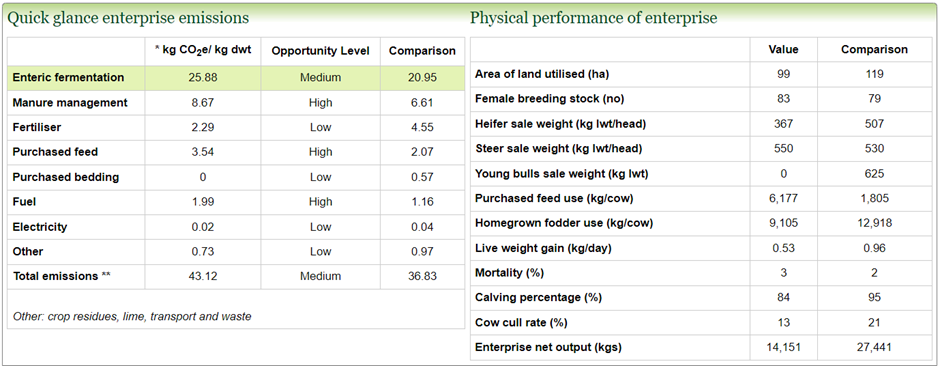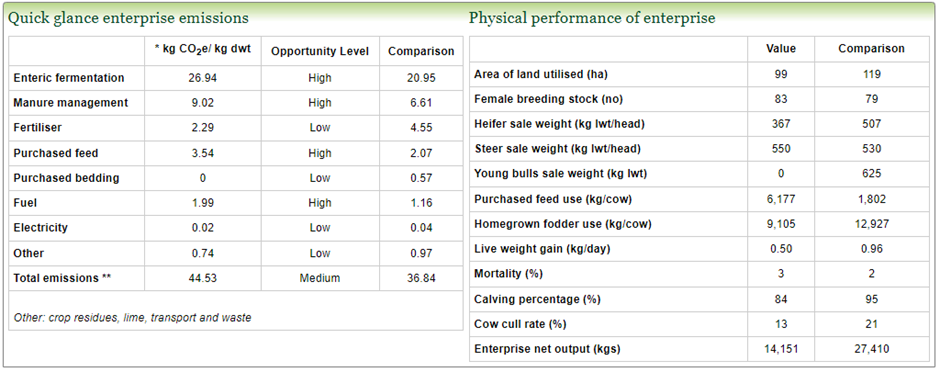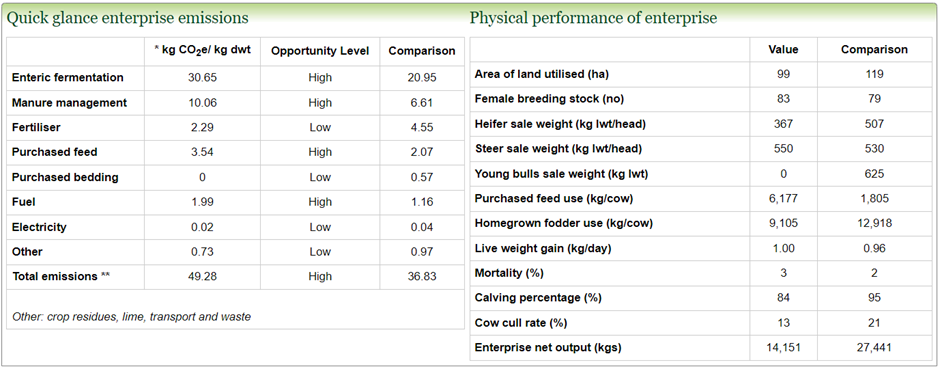Carbon Audits for Beef Enterprises – The Difference Accurate Data Makes
13 September 2024One of the core features of Agrecalc is its ability to benchmark your farming enterprise against other similar enterprises. But to get the benefit from the tool’s substantial dataset you need to provide the software with accurate data.
Furthermore, without accurate data in the first instance when you set up the software, it becomes harder to properly measure the changes to emissions your business makes over time as you implement improvements and become more efficient.
How to get accurate data, and what to look out for
Within the data required there are some things which are easier to calculate or obtain than others. Figures such as sale weight or purchase weight are easily obtained from purchase or sale receipts, so this is a good place to start.
Things such as weights of cattle on farm or cattle daily liveweight gains may not be so readily available if a scale is not present on farm. Fuel allocation may also prove difficult especially where there are multiple enterprises on farm or if there is work carried out away from the farm or contractors coming on farm who bring fuel with them.
Without this information it can become more difficult to say for certain what the carbon footprint is for each enterprise. Trying to get these figures as accurate as possible will therefore give the best chance of an accurate representation of your farm.
The difference data makes to a beef enterprise
One of the more difficult enterprises to get all figures for is beef. Some of the more difficult figures to gauge accurately for beef enterprises, especially suckler enterprises are:
- The average weights of the cow through the year.
- Daily liveweight gain
Below we will demonstrate the impact inaccurately reporting this data can have on your carbon audit, and make some suggestions about how you can get started collecting more accurate data about your farm.
Average cow weight
It’s not unheard of for consultants, sat at the farmers table, to have been looking at cows touching 750-800kg and be told the average weight is 550kg. This, from a carbon point of view, makes a large difference, as illustrated below.

This is the actual figures for a carbon audit with cow average weight of 550kg.

This is the same audit with the only figure changed being the average weight of the cows to 650kg, this doesn’t create a big discrepancy in the total emissions figures for this enterprise at 3.3%, calculated by taking the difference in total emissions between the two examples and then working this out as a percentage change from the original data, however this is still a big enough change to start to skew your figures slightly.

This is the same audit again with the only change in the figures being the average cow weight changed to 750kg, by using the same calculation method of working out the difference and then getting that as a percentage change on original figures the change in this data is 6.5% which is starting to become a relatively significant change.
Granted, the average weight of a cow over a year is a very difficult figure to obtain without a scale to weigh them at different points throughout the year. A heavily pregnant cow is going to weigh a lot more than a cow which has been suckling a calf for several months. Using sale weights of cull cows is one way of starting to get a picture of the weight even if they are fed for going away this is likely to be similar in weight to a pregnant cow so starting from this figure will give you a good idea. as Additionally, from a carbon point of view and the nutrition data that pulls into the calculations, it is important that this is accurate.
Daily liveweight gain
Another figure which is often entered incorrectly and makes a large difference to results is the daily liveweight gain of the animals. Often this is just left as the standard figures but if you work it out from length of time on farm and weight gain from arrival to departure it is often vastly different to the figures which are classed as standard. Using the same starting example as above the only figure changed in the examples below was the daily liveweight gain;

This has been changed from the original 0.53 to 0.75kg/day. You may think that this should reduce the carbon footprint but in actual fact if the numbers on the ground do not reflect this weight gain it has the opposite effect, showing a 7% increase in the carbon footprint for this enterprise just through incorrect calculations of the data.

This second example is changed to 1kg/day and shows a 14.3% increase in the carbon footprint. This is something which could quite easily be overlooked when entering data but as can be seen from the above can make a large difference in the end figures.
How to collect average cow weight and daily liveweight
The above two examples show just a small glimpse of how small discrepancies in the data can make a relatively large difference in the final results of your audit. Therefore trying to make data as accurate as possible is beneficial for both yourself and the general benchmarks held within Agrecalc or similar platforms.
If you are unsure how to accurately record your average cow weight, consider starting with the weight of any cull cows you sell, looking at these or handling them and then looking at and handling your working cows will give a starting point to work out how heavy they are, this also applies to any purchased or sold cattle, generally there will be weights available for these so run your eyes and hands over them and start to build up a fuller picture of where they will sit weight wise. This is good practise for working out feed rations as well as for exercises such as carbon audits.
If collecting daily liveweight is a challenge, you could try taking the sale weight and the number of days on farm and making the calculation based on its entire life on your holding, eg if selling calves at 400kg at say 14 months old you would take the 14 months as around 425 days take the 400kg and subtract birth weight or a close estimation, somewhere around 30-50kg in general, and then divide the say 360kg of weight gain by the 425 days to get a daily liveweight gain figure of 0.85kg/day. If you are keeping them to finish then the same calculations can be applied, always remembering to subtract the birth weight prior to making the calculation.
Further information on this topic and more is available throughout the FAS website, we would recommend starting with our Preparing For The Future page. If you have further questions, the FAS Advice line is free and impartial, and can be reached either by emailing advice@fas.scot or by calling 0300 323 0161.
Charles Bruce, SAC Consulting
For more information see:
fas.scot/downloads/benefits-of-weighing-cattle/
Do You Know What Your Cows Weigh? | Helping farmers in Scotland | Farm Advisory Service (fas.scot)
Sign up to the FAS newsletter
Receive updates on news, events and publications from Scotland’s Farm Advisory Service
















